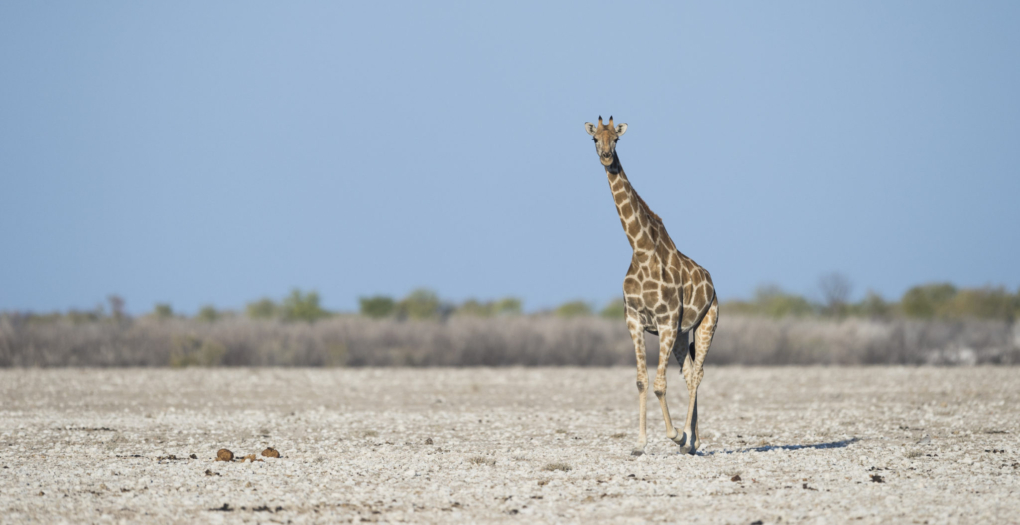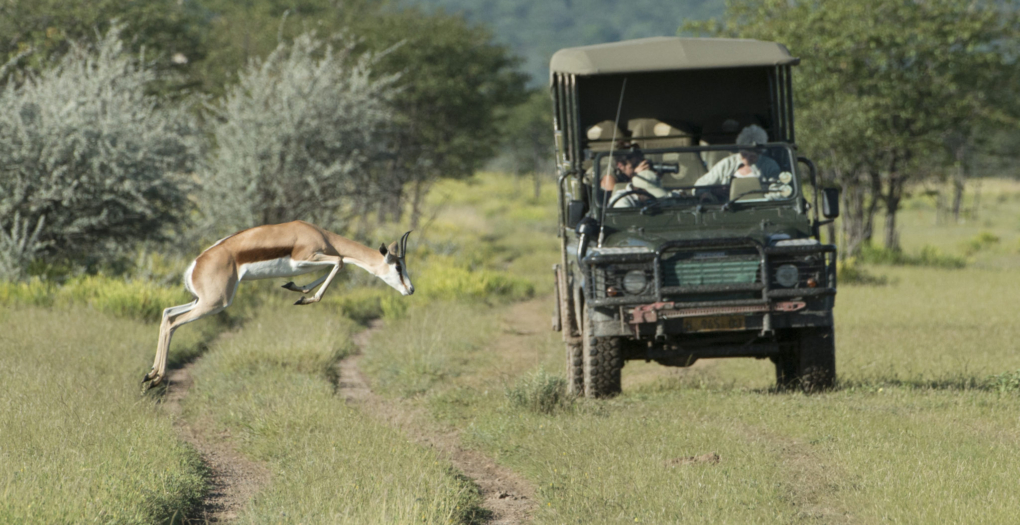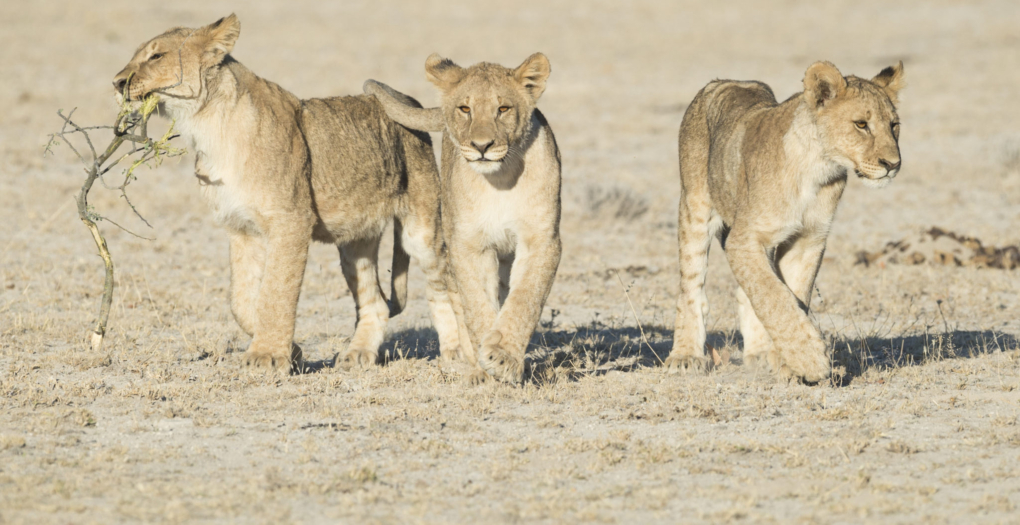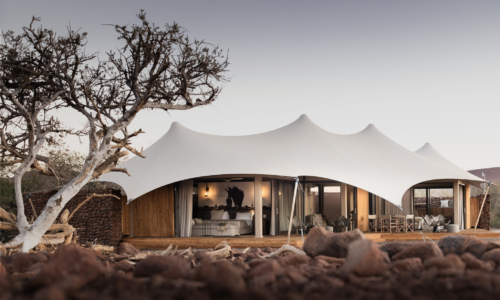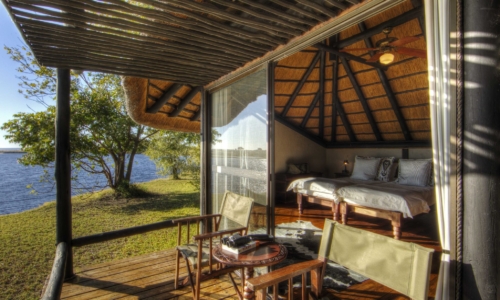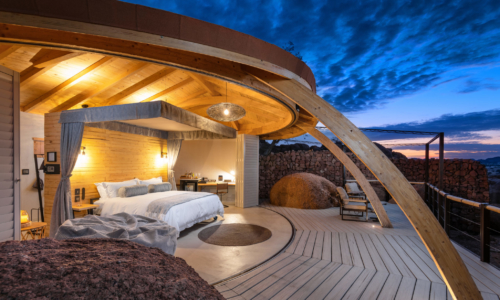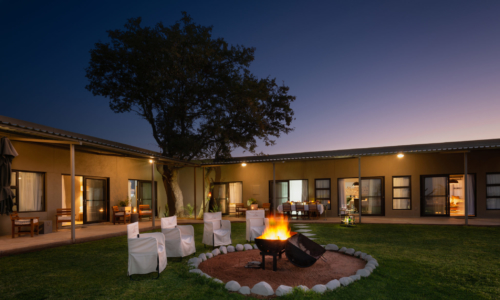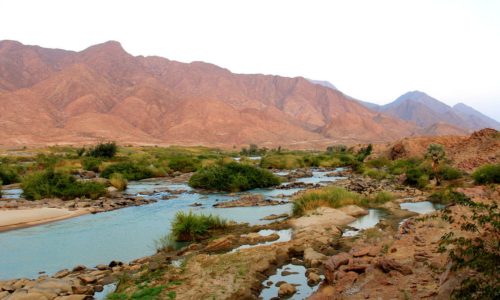Created as a game reserve in 1907 and then declared a national park in 1967, Etosha is Namibia’s premiere wildlife destination covering a diverse range of landscapes including desert, semi-desert, and savanna. The park is named for and dominated by the Etosha Pan, a salt desert that is nearly completely barren in the dry winter months. While it is so large it can be seen from space, the Etosha Pan only makes up a third of the park itself. Perennial springs along the edges of the pan create natural waterholes that draw daily concentrations of wildlife and wildfowl. In addition to the saltpan, the park is covered by mopane scrubland as well as tall tree forests of the unique moringa or “ghost tree.” There are even wide expanses of grassland and the undulating reddish-brown landscape of dolomite in the west.
Part of Etosha’s charms lie in the fact that the animals are easy to find. Just park next to one of the many waterholes and a veritable host of animals including lions, elephants, springboks, gemsboks, giraffes, and more will come by the hundreds. At night, floodlights on the water holes illuminate the nocturnal doings of lions, cheetah, elephants, and rhinos. During summer, the rains turn the saltpan into a shallow lake that attracts thousands of migratory birds, most notably pelicans and flamingos.
The 526-mile fence surrounding the park protects the reserve’s diverse wildlife from external contamination and has resulted in many healthy populations. From May to September, game viewing is excellent and promises sightings of the endemic black-faced impala and endangered black rhinoceros. Dolomite in the western section of the park is the only place to see Hartmann’s mountain zebra.
Etosha is also one of the most accessible game reserves in Namibia and Southern Africa. Not only is the area malaria free, the roads are accessible by a regular car and there are plenty of rest areas, restaurants, viewing decks, shops, and gas stations around. Of course, the safari camps in the park offer day and night game drives led by expert guides for knowledgeable viewing of the abundant wildlife, especially around the water holes. Other excursions take in the vast salt pan known as the great white place and even used as a backdrop in the film 2001: A Space Odyssey.

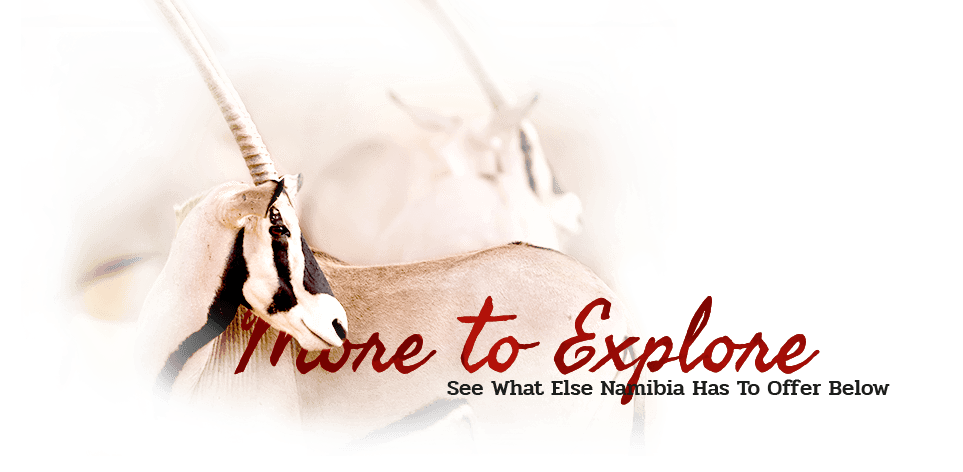
- Anderssons at Ongava
- Babson House
- Camp Kipwe
- Canyon Lodge
- Canyon Roadhouse
- Canyon Village
- Cape Cross Lodge
- Chobe Savanna Lodge
- Damara Mopane Lodge
- Damaraland Camp
- Dead Valley Lodge
- Desert Hills Glamping Camp
- Desert Homestead
- Desert Homestead Outpost
- Desert Rhino Camp
- Dolomite Camp
- Doro Nawas Camp
- Eagle’s Nest Lodge
- Erongo Wilderness Lodge
- Etosha Heights Safari House
- Etosha Mountain Lodge
- Etosha Safari Camp
- Etosha Safari Lodge
- Fish River Lodge
- Fort Sesfontein Lodge
- Grootberg Lodge
- Halali Camp
- Hoanib Skeleton Coast Camp
- Hoanib Valley Camp
- Ichingo Chobe River Lodge
- Kalahari Anib Lodge
- Kalahari Farmhouse
- Khorixas Rest Camp
- Kulala Desert Lodge
- Kwessi Dunes
- Little Kulala
- Little Ongava
- Malansrus Tented Camp
- Mowani Mountain Camp
- Mushara Bush Camp
- Mushara Lodge
- Mushara Outpost
- Naankuse Lodge
- Namib Desert Lodge
- Namushasha River Lodge
- Namutoni Camp
- Nhoma Safari Camp
- Okahirongo Elephant Lodge
- Okahirongo River Camp
- Okaukuejo Camp
- Okonjima Bush Camp
- Okonjima Bush Suite
- Okonjima Grand African Villa
- Okonjima Plains Camp
- Onduli Ridge
- Ongava Lodge
- Ongava Tented Camp
- Onguma Bush Camp
- Onguma Etosha Aoba Lodge
- Onguma Tented Camp
- Onguma The Fort
- Onguma Tree Top Camp
- Onkoshi Camp
- Ozondjou Trails
- Popa Falls Camp
- River Crossing Lodge
- Safarihoek Lodge
- Serra Cafema Camp
- Shipwreck Lodge
- Sossus Dune Lodge
- Sossusvlei Desert Lodge
- Terrace Bay Camp
- Teufelskrallen Tented Lodge
- Villa Mushara
- Wolwedans Boulders Safari Camp
- Wolwedans Dune Camp
- Wolwedans Dunes Lodge
- Wolwedans Mountain View Suite
- Wolwedans Private Camp
- Anderssons at Ongava
- Babson House
- Camp Kipwe
- Canyon Lodge
- Canyon Roadhouse
- Canyon Village
- Cape Cross Lodge
- Chobe Savanna Lodge
- Damara Mopane Lodge
- Damaraland Camp
- Dead Valley Lodge
- Desert Hills Glamping Camp
- Desert Homestead
- Desert Homestead Outpost
- Desert Rhino Camp
- Dolomite Camp
- Doro Nawas Camp
- Eagle’s Nest Lodge
- Erongo Wilderness Lodge
- Etosha Heights Safari House
- Etosha Mountain Lodge
- Etosha Safari Camp
- Etosha Safari Lodge
- Fish River Lodge
- Fort Sesfontein Lodge
- Grootberg Lodge
- Halali Camp
- Hoanib Skeleton Coast Camp
- Hoanib Valley Camp
- Ichingo Chobe River Lodge
- Kalahari Anib Lodge
- Kalahari Farmhouse
- Khorixas Rest Camp
- Kulala Desert Lodge
- Kwessi Dunes
- Little Kulala
- Little Ongava
- Malansrus Tented Camp
- Mowani Mountain Camp
- Mushara Bush Camp
- Mushara Lodge
- Mushara Outpost
- Naankuse Lodge
- Namib Desert Lodge
- Namushasha River Lodge
- Namutoni Camp
- Nhoma Safari Camp
- Okahirongo Elephant Lodge
- Okahirongo River Camp
- Okaukuejo Camp
- Okonjima Bush Camp
- Okonjima Bush Suite
- Okonjima Grand African Villa
- Okonjima Plains Camp
- Onduli Ridge
- Ongava Lodge
- Ongava Tented Camp
- Onguma Bush Camp
- Onguma Etosha Aoba Lodge
- Onguma Tented Camp
- Onguma The Fort
- Onguma Tree Top Camp
- Onkoshi Camp
- Ozondjou Trails
- Popa Falls Camp
- River Crossing Lodge
- Safarihoek Lodge
- Serra Cafema Camp
- Shipwreck Lodge
- Sossus Dune Lodge
- Sossusvlei Desert Lodge
- Terrace Bay Camp
- Teufelskrallen Tented Lodge
- Villa Mushara
- Wolwedans Boulders Safari Camp
- Wolwedans Dune Camp
- Wolwedans Dunes Lodge
- Wolwedans Mountain View Suite
- Wolwedans Private Camp

Created as a game reserve in 1907 and then declared a national park in 1967, Etosha is Namibia’s premiere wildlife destination covering a diverse range of landscapes including desert, semi-desert, and savanna. The park is named for and dominated by the Etosha Pan, a salt desert that is nearly completely barren in the dry winter months. While it is so large it can be seen from space, the Etosha Pan only makes up a third of the park itself. Perennial springs along the edges of the pan create natural waterholes that draw daily concentrations of wildlife and wildfowl. In addition to the saltpan, the park is covered by mopane scrubland as well as tall tree forests of the unique moringa or “ghost tree.” There are even wide expanses of grassland and the undulating reddish-brown landscape of dolomite in the west.
Part of Etosha’s charms lie in the fact that the animals are easy to find. Just park next to one of the many waterholes and a veritable host of animals including lions, elephants, springboks, gemsboks, giraffes, and more will come by the hundreds. At night, floodlights on the water holes illuminate the nocturnal doings of lions, cheetah, elephants, and rhinos. During summer, the rains turn the saltpan into a shallow lake that attracts thousands of migratory birds, most notably pelicans and flamingos.
The 526-mile fence surrounding the park protects the reserve’s diverse wildlife from external contamination and has resulted in many healthy populations. From May to September, game viewing is excellent and promises sightings of the endemic black-faced impala and endangered black rhinoceros. Dolomite in the western section of the park is the only place to see Hartmann’s mountain zebra.
Etosha is also one of the most accessible game reserves in Namibia and Southern Africa. Not only is the area malaria free, the roads are accessible by a regular car and there are plenty of rest areas, restaurants, viewing decks, shops, and gas stations around. Of course, the safari camps in the park offer day and night game drives led by expert guides for knowledgeable viewing of the abundant wildlife, especially around the water holes. Other excursions take in the vast salt pan known as the great white place and even used as a backdrop in the film 2001: A Space Odyssey.

- Anderssons at Ongava
- Babson House
- Camp Kipwe
- Canyon Lodge
- Canyon Roadhouse
- Canyon Village
- Cape Cross Lodge
- Chobe Savanna Lodge
- Damara Mopane Lodge
- Damaraland Camp
- Dead Valley Lodge
- Desert Hills Glamping Camp
- Desert Homestead
- Desert Homestead Outpost
- Desert Rhino Camp
- Dolomite Camp
- Doro Nawas Camp
- Eagle’s Nest Lodge
- Erongo Wilderness Lodge
- Etosha Heights Safari House
- Etosha Mountain Lodge
- Etosha Safari Camp
- Etosha Safari Lodge
- Fish River Lodge
- Fort Sesfontein Lodge
- Grootberg Lodge
- Halali Camp
- Hoanib Skeleton Coast Camp
- Hoanib Valley Camp
- Ichingo Chobe River Lodge
- Kalahari Anib Lodge
- Kalahari Farmhouse
- Khorixas Rest Camp
- Kulala Desert Lodge
- Kwessi Dunes
- Little Kulala
- Little Ongava
- Malansrus Tented Camp
- Mowani Mountain Camp
- Mushara Bush Camp
- Mushara Lodge
- Mushara Outpost
- Naankuse Lodge
- Namib Desert Lodge
- Namushasha River Lodge
- Namutoni Camp
- Nhoma Safari Camp
- Okahirongo Elephant Lodge
- Okahirongo River Camp
- Okaukuejo Camp
- Okonjima Bush Camp
- Okonjima Bush Suite
- Okonjima Grand African Villa
- Okonjima Plains Camp
- Onduli Ridge
- Ongava Lodge
- Ongava Tented Camp
- Onguma Bush Camp
- Onguma Etosha Aoba Lodge
- Onguma Tented Camp
- Onguma The Fort
- Onguma Tree Top Camp
- Onkoshi Camp
- Ozondjou Trails
- Popa Falls Camp
- River Crossing Lodge
- Safarihoek Lodge
- Serra Cafema Camp
- Shipwreck Lodge
- Sossus Dune Lodge
- Sossusvlei Desert Lodge
- Terrace Bay Camp
- Teufelskrallen Tented Lodge
- Villa Mushara
- Wolwedans Boulders Safari Camp
- Wolwedans Dune Camp
- Wolwedans Dunes Lodge
- Wolwedans Mountain View Suite
- Wolwedans Private Camp
- Anderssons at Ongava
- Babson House
- Camp Kipwe
- Canyon Lodge
- Canyon Roadhouse
- Canyon Village
- Cape Cross Lodge
- Chobe Savanna Lodge
- Damara Mopane Lodge
- Damaraland Camp
- Dead Valley Lodge
- Desert Hills Glamping Camp
- Desert Homestead
- Desert Homestead Outpost
- Desert Rhino Camp
- Dolomite Camp
- Doro Nawas Camp
- Eagle’s Nest Lodge
- Erongo Wilderness Lodge
- Etosha Heights Safari House
- Etosha Mountain Lodge
- Etosha Safari Camp
- Etosha Safari Lodge
- Fish River Lodge
- Fort Sesfontein Lodge
- Grootberg Lodge
- Halali Camp
- Hoanib Skeleton Coast Camp
- Hoanib Valley Camp
- Ichingo Chobe River Lodge
- Kalahari Anib Lodge
- Kalahari Farmhouse
- Khorixas Rest Camp
- Kulala Desert Lodge
- Kwessi Dunes
- Little Kulala
- Little Ongava
- Malansrus Tented Camp
- Mowani Mountain Camp
- Mushara Bush Camp
- Mushara Lodge
- Mushara Outpost
- Naankuse Lodge
- Namib Desert Lodge
- Namushasha River Lodge
- Namutoni Camp
- Nhoma Safari Camp
- Okahirongo Elephant Lodge
- Okahirongo River Camp
- Okaukuejo Camp
- Okonjima Bush Camp
- Okonjima Bush Suite
- Okonjima Grand African Villa
- Okonjima Plains Camp
- Onduli Ridge
- Ongava Lodge
- Ongava Tented Camp
- Onguma Bush Camp
- Onguma Etosha Aoba Lodge
- Onguma Tented Camp
- Onguma The Fort
- Onguma Tree Top Camp
- Onkoshi Camp
- Ozondjou Trails
- Popa Falls Camp
- River Crossing Lodge
- Safarihoek Lodge
- Serra Cafema Camp
- Shipwreck Lodge
- Sossus Dune Lodge
- Sossusvlei Desert Lodge
- Terrace Bay Camp
- Teufelskrallen Tented Lodge
- Villa Mushara
- Wolwedans Boulders Safari Camp
- Wolwedans Dune Camp
- Wolwedans Dunes Lodge
- Wolwedans Mountain View Suite
- Wolwedans Private Camp








